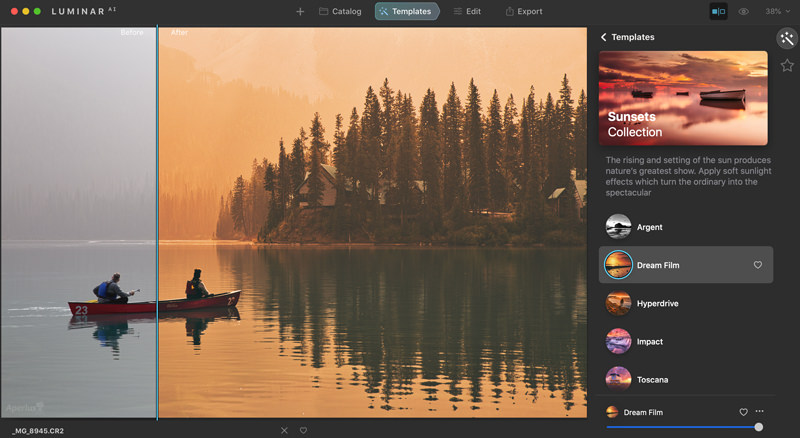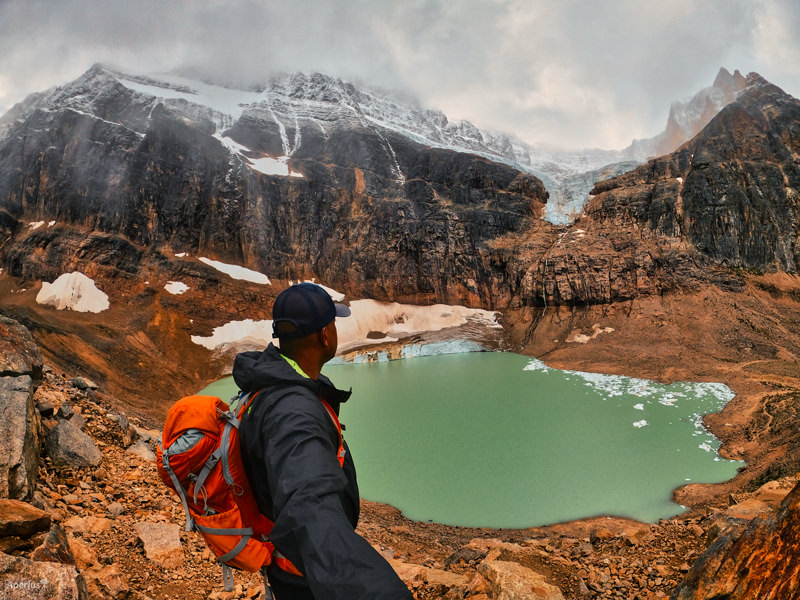Last updated on March 6th, 2024
TL;DR Summary of Luminar Review
Luminar AI is the fastest creative image software that allows photographers to add an artistic touch to their landscape, wildlife, and portrait photos. Its AI engine allows seamless Photoshop-like edits in less than 30 seconds without wasting time with PS layers, masking, and brushes. Update: Luminar AI is now succeeded by Luminar Neo. Read the Luminar Neo review for more information.
Faster Edits. Better Photos.
Skylum is now in hyperdrive in the photo-editing business with its upcoming Luminar AI software.
They’re banking on artificial intelligence to help creative photographers and artists pump out more aesthetic photographs in a shorter amount of time.
I’ll also show some before-and-after images using Luminar AI to give you an idea of what the software can produce.
Luminar Review
As usual, I’m not going to summarize every little detail of Luminar AI; otherwise, this would be a boring read unless you’re in bed and want to fall asleep.
But I will mention the highlights of Luminar AI and what I think is essential.


What is Luminar AI?
Luminar AI is a standalone creative image editor built with an artificial intelligence platform and also available as a plugin.
The idea behind Luminar AI is to get images edited faster with little user input. If you still enjoy the process of a steady photography workflow and like manual edits, then you can still do that.
But on lazy days — or when your creative juices are lacking — then Luminar AI will give you that inspiration in a few clicks.
Furthermore, Luminar AI can also be used as an image management software. But by no means is the image management as comprehensive as Lightroom or Capture One.
But where Luminar AI lacks in photo management, it excels in image editing and creative photography.
How Does Luminar AI Work?
Luminar is AI-powered and it’s supposedly the first that heavily relies on artificial intelligence. Topaz Labs is also AI-powered but its software is a collection of individual apps, whereas Luminar AI is more of an all-in-one AI photo editor.
After testing other photography software, I can confirm that Luminar AI uses the most artificial intelligence for photo editing.
To cut to the chase, the software recommends specific templates depending on the type of image you have. For example, if you have a landscape photo, then Luminar AI will recommend landscape templates. On the other hand, for portraits, it will suggest portrait templates.

But it’s not only the recommended templates that are based on artificial intelligence; some of the individual tools or technologies also use AI. Let’s say you’re adding detail or structure to your landscape photo, then Luminar AI will make sure not to add detail to the sky, thus avoiding increased noise detail.
The artificial intelligence of Luminar works by using a neural network. In other words, thousands of photos are fed to the algorithm to determine what type of image it is (landscape, portrait, wildlife, etc.) and what’s what (face, eyes, sky, water, etc.). This is done repeatedly on a pass-fail testing scenario until the software can determine the type of image and the objects in the image accurately. Hopefully, my explanation makes sense, but it pretty much uses a recognition algorithm.
Luminar AI Major Features
Now we get into the core of Luminar AI and find out what all the hype is about. The software has many tools, but I’m only mentioning a few of them.
Composition AI
Composition AI provides a suggested crop for your image. This tool is more suitable for beginner photographers that aren’t experienced in composition.
AI Image-Based Template Suggestions
As mentioned earlier, Luminar AI recommends templates that are most suitable for your image. This helps with choosing the correct template or preset, resulting in faster end-to-end photo editing.
A major advantage of this AI technology is photographers don’t need to test several presets like they do in Lightroom or save collections of templates.
Supercontrast
Precisely add contrast to your highlights, midtones, and shadows without affecting the entire image nor adding a mask.
Atmosphere AI
Add haze, fog, or mist to your outdoor image to give it a calm or mellow-dramatic feel. Remember the movie Sleepy Hollow with Johnnie Depp? That’s the look I’m thinking. 🙂
Structure AI
Remember, I mentioned how Luminar’s artificial intelligence works? Well, Structure AI adds detail or texture to all the correct places without ruining the overall image. You can use this tool for wildlife, faces, landscapes, etc.
Sky AI
Dull sky? No problem. Landscape photographers can quickly replace the sky with no masking required. More importantly, the sky’s lighting will also match the foreground and the rest of the image. A few adjustments are also available to fine-tune the sky.
Commercial or real photographers will also find this tool beneficial.
Is replacing the sky ethical? Well, it depends on how you look at it.
Augmented Sky AI
Complimenting the Sky AI replacement tool is Augmented Sky AI, allowing users to quickly add objects to a landscape image to give an instant artistic look.
You’ll be able to add birds, aurora, moon, and more to the sky. Augmented Sky AI comes packaged with a few sky objects, or you can add your own.
Mood and Color Harmony
Luminar AI’s Mood tool allows you to use different color palettes with traditional LUT files.
The Color Harmony tool builds on the regular HSL sliders to target different color channels and provide photographers a more robust color grading option.


Face AI
Quickly relight the face, slim the face, improve the eyes, and more with Face AI.
Skin AI
The Skin AI helps to remove blemishes from the skin. It can also help reduce glare or the appearance of oily skin.
This tool best works combined with the Erase tool, which is like the healing brush tool of Lightroom or Photoshop.
Luminar AI vs Luminar 4
So, the big question is should you get Luminar AI vs Luminar 4? Or maybe you already own Luminar 4 and are thinking about upgrading.
Here’s what we know about Luminar AI and Luminar 4.
Luminar 4 was released at the end of 2019, whereas Luminar AI was released at the end of 2020.
Both software are AI-based, but Luminar AI is more AI-based, if that makes any sense, mainly because Luminar AI is trying to save a lot more time with suggesting templates. Luminar 4 also has templates, but they’re called Looks, and none are automatically suggested.
Luminar AI and Luminar 4 both have several common technologies like Sky AI, Augmented Sky AI, Face AI, etc. The names of the tools may vary slightly.
A noticeable and important difference is Luminar 4 supports user-created layers, whereas Luminar AI doesn’t. This is because Luminar AI relies more on artificial intelligence and does masking in the background. But you can still adjust the mask in Luminar AI of the individual tools.
Should you upgrade from Luminar 4 to Luminar AI?
If you’re looking for faster edits, then Luminar AI may be a good fit for you. Otherwise, Luminar 4 will suffice. I suggest testing Luminar AI for free.
Price
Luminar AI costs $99 for a perpetual license. You can use coupon code aperlust for $10 off the regular price of Luminar AI.
If you already own Luminar 4 or Aurora HDR, you should be eligible for an upgrade discount.
Luminar AI System Requirements
Windows
Windows-based hardware PC with mouse or similar input device
CPU Intel® Core™ i5 or better, AMD Ryzen™ 5 or better
Windows 10 (only 64-bit OS)
Memory 8 GB RAM or more (16+ GB RAM is recommended)
Hard disk 10 GB free space; SSD for best performance
1280×768 size or better display
Open GL 3.3 or later compatible graphics card
macOS
MacBook, MacBook Air, MacBook Pro, iMac, iMac Pro, Mac Pro, Mac mini, early 2010 or newer
CPU Intel® Core™ i5 or better
macOS 10.13.6 or higher
Memory 8 GB RAM or more (16+ GB RAM is recommended)
Hard disk 10 GB free space; SSD for best performance
1280×768 size or better display
Conclusion
After my review of Luminar AI, I like what Skylum is doing with the software. Instead of duplicating Lightroom or other digital asset managers, they are making a comprehensive creative image editor for faster workflows.
Luminar 4, and now Luminar AI, are some of the few photography software that I continue to use after testing because they provide me a solution — they help make my travel photos more creative.
Should you buy Luminar AI? That depends on your situation.
If you’re a professional photographer, Luminar AI will be more of an add-on to your workflow. It’ll help you save a considerable amount of time with masking in Photoshop. You’ll probably still need a comprehensive digital asset manager.
On the other hand, if you’re a hobbyist or beginner photographer, and want to avoid the Adobe Creative Cloud monthly fee, then Luminar AI is a cost-effective photography tool. It’s even more useful if you already use Instagram (my account) or any other mobile app for creative edits — Luminar AI simply takes the creativity a bit further.
Frequently Asked Questions
Do I need Luminar AI if I already own Luminar 4?
Technically, you don’t need Luminar AI if you already own Luminar 4. But if you want to edit faster and be provided more creativity, you should test out Luminar AI.
Is Luminar AI a free upgrade from Luminar 4?
No, Luminar AI is not a free upgrade. However, there is an upgrade discount, which you can check out here.
When is the Luminar AI release date?
Skylum has not officially provided the release date of Luminar AI. However, they stated it would be released during the 2020 holiday season.
Can Luminar AI replace Lightroom?
Luminar AI and Lightroom are two different types of photography software with common features. One can’t replace the other as they both have their pros and cons.
Can Luminar AI replace Photoshop?
No, Luminar AI can’t replace Photoshop because they are two different photography software with mutually inclusive tools. Photoshop is an advanced raster image and graphic editor able to complete complex edits. Luminar AI uses artificial intelligence to edit photos quickly.

